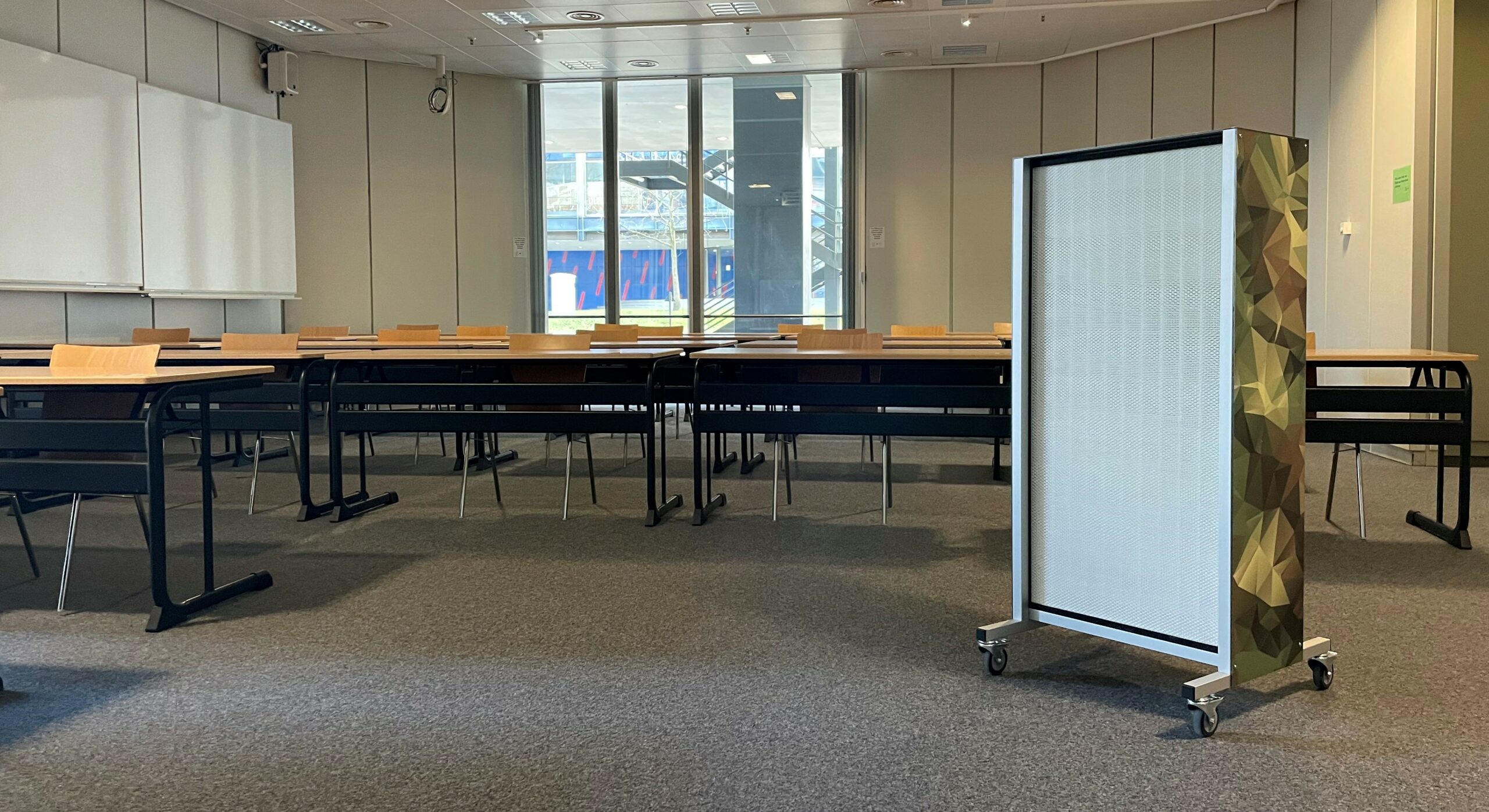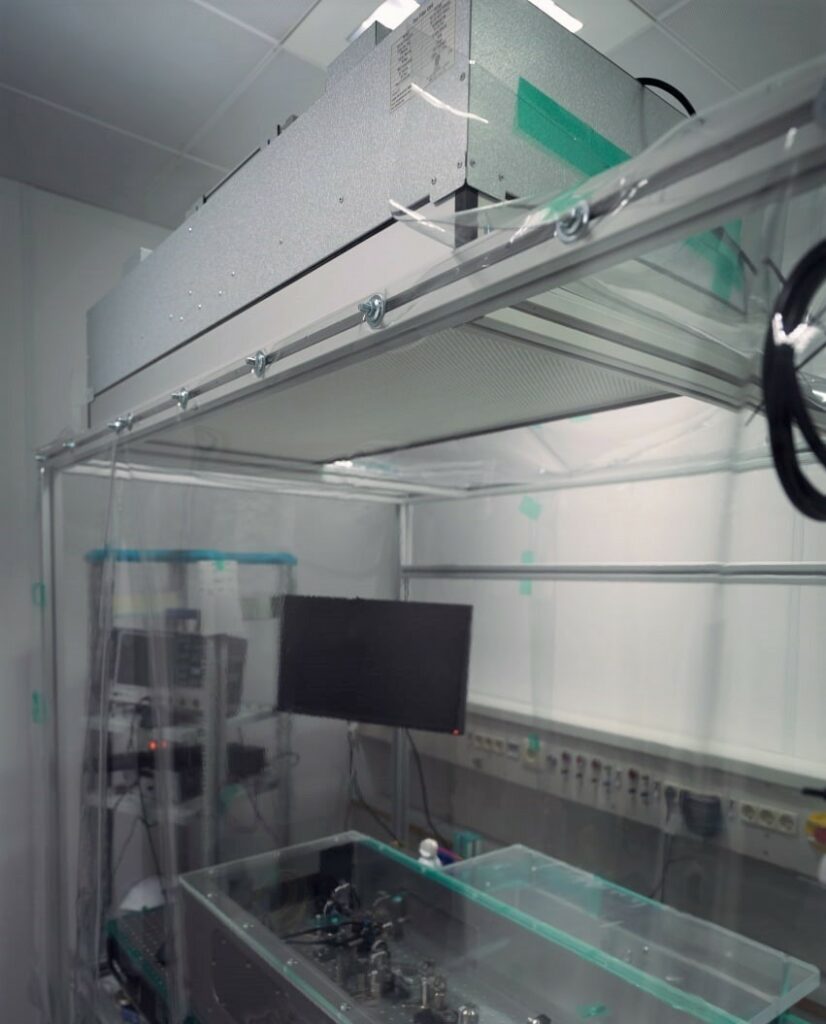More and more experts are calling for the use of air purifiers with HEPA filters to counteract the spread of the corona virus. In particular, facilities with a poor ventilation system and high occupancy density are equipped with various air purifiers. When choosing the device, the focus should be on three key indicators: a high volume flow, high efficiency and low noise.
Interestingly, the technological solution that provides the perfect combination of these parameters has been used for decades. We are talking about so-called Filter Fan Units (FFUs), which are used in particular in the semiconductor and pharmaceutical industries. The FFUs are very robust and easy to operate. However, the biggest advantage of these units over commercial air cleaners is their low price. Employees under the leadership of Prof. Dr. Pronin are therefore using mobile FFUs for an area-wide deployment of cost-efficient air purifiers at HSU.

How the project came about
It is October 2020. A PhD student of the LTS professorship is infected with Corona without knowing it. Together with Prof. Pronin and another PhD student, he works for over an hour in a small, poorly ventilated laboratory. Nevertheless, neither Prof. Pronin nor the other doctoral student became infected.
“It surprised me what a high level of protection our surgical masks offered,” says Prof. Pronin. “But then I noticed that an air purifier (FFU, see Fig. 2) was running in the laser lab all the time.” They are designed to remove dust and other particles from the air in highly sensitive areas. Equipped with a HEPA 14 filter, they are thus also effective against dangerous corona aerosols. “I realize that we have also simply been lucky and there is no such thing as 100 percent protection. Nevertheless, we should use the technological means at our disposal. At the end of the day, masks are just filters. And there are much more powerful filters out there!”
The FFUs remove over 99.995% of all particles from the air 1, helping not only against coronaviruses, but also against other pathogens and pollen.
his study 2 on the effectiveness of these devices caused a stir. According to this study, three key figures in particular are important for the choice of air purifier 3:
Volume flow, Effectiveness und Loudness.

FFUs as air purifiers
Filter Fan Units use a HEPA 14 filter and perform at a high flow rate. Air purifiers with comparable values usually cost over €2,000. Such prices prevent widespread use. This gave Prof. Pronin the idea of using industrially used FFUs as a much cheaper alternative. “Thanks to the very manageable initial costs, we can install a large number of room air cleaners at HSU,” explains Prof. Pronin. HSU has already procured 20 FFUs as room air cleaners and ordered another 50 units. “I believe that with a suitable concept of masks and air purifiers, we can basically enable face-to-face teaching and create a safe atmosphere for students as well as colleagues during classes.”
This project led to the spin-off company Nordair Systems.
Volume flow
The volume flow rate indicates how many cubic meters of air can be cleaned per hour. In order to be sufficiently protected even in a room with several people, an air exchange rate of 6 – 10 per hour 2 4 is required. This means that the volume flow of the air purifiers should be about six to ten times the volume of the room per hour. This view is also shared by Prof. Curtius from Goethe University in his study on mobile air purifiers 5.
Effectiveness
The efficiency (or filtration efficiency) describes how effectively the air can be cleaned. For a quick overview of the collection efficiency, filters are classified according to the EN 1822 standard 1 . In medical facilities such as hospitals, HEPA 14 filters have been used for many years 6 7 . These filters remove from the air over 99.995% of particles with a size around 0.3 μm 8 , the most difficult particle size to filter. Smaller particles around the 0.1 μm coronavirus size or larger aerosols contaminated with coronavirus are virtually 100% removed.2 9 10 .
Loudness
The school class studied by Prof. Curtius found a volume of 48 dB(A) not disturbing 5. Experience at HSU has shown that at a volume above approx. 55 dB(A) the output is reduced again. In order to achieve a sufficient air exchange rate even in large rooms, several air cleaners can be used. This also offers the advantage that the air in the room is cleaned more homogeneously 5.
UV-C Aircleaner
Some devices use UV-C radiation to render the viruses harmless by means of light with a wavelength of 100 nm to 280 nm 11. However, the viruses must be irradiated for a certain time and the air must therefore be passed slowly through the purifier. This means that only a low volume flow is possible 12.
1) BRITISCH STANDARD,. (2009). High efficiency air filters (EPA, HEPA and ULPA) (BS EN1822-1:2009). Online abgerufen von: https://weerhuisje.eu/pdf/EN1822-1-2009_Highefficiencyairfilters_EPA_HEPA_ULPA_Part1_Classification_performance.pdf
2) Kähler, C. J., Fuchs, T., & Hain, R. (2020). Können mobile Raumluftreiniger eine indirekte SARS-CoV-2 Infektionsgefahr durch Aerosole wirksam reduzieren. Hg. v. Universität der Bundeswehr München. Strömungsmechanik und Aerodynamik. Online abgerufen von: https://www.unibw.de/lrt7/raumluftreiniger.pdf (zuletzt abgerufen am 18.02.2021).
3) Exner, M., Walger, P., Gebel, J., Schmithausen, R., Kramer, A., & Engelhart, S. (2020). Zum Einsatz von dezentralen mobilen Luftreinigungsgeräten im Rahmen der Prävention von COVID-19. Stellungnahme der Deutschen Gesellschaft für Krankenhaushygiene (DKKH). Bonn.
4) American Society of Heating, Refrigerating and Air-Conditioning Engineers. (2020). Ventilation of Health Care Facilities (ANSI/ASHRAE/ASHE Standard 170-2017). Online abgerufen von: https://www.ashrae.org/file%20library/technical%20resources/standards%20and%20guidelines/standards%20errata/standards/170_2017_a_20200901.pdf
5) Curtius, J., Granzin, M., & Schrod, J. (2021). Testing mobile air purifiers in a school classroom: Reducing the airborne transmission risk for SARS-CoV-2. Aerosol Science and Technology, 1-18.
6) Deutsche Gesellschaft für Krankenhaushygiene (2015) Krankenhaushygienische Leitlinie für die Planung, Ausführung und den Betrieb von Raumlufttechnischen Anlagen in Räumen des Gesundheitswesens. Hyg Med 2015; 40 – 12
7) Deutsche Gesellschaft für Krankenhaushygiene (2002) Leitlinienentwurf: Ausführung und Betrieb von raumlufttechnischen Anlagen (RLT-Anlagen) in Krankenhäusern. Hyg Med 27. Jahrgang 2002 – Heft 3
8) Robertson, P. (2019, 20. August) Can HEPA Filters Capture Nanoparticles? Clean Air Blog. https://smartairfilters.com/en/blog/can-hepa-filters-capture-nanoparticles/
9) Robertson, P. (2021, 01. Januar) Can HEPA Filters and Air Purifiers Capture the Coronavirus? Clean Air Blog. https://smartairfilters.com/en/blog/can-air-purifiers-remove-filter-out-coronavirus/
10) Perry, J. L., Agui, J. H., & Vijayakimar, R. (2016). Submicron and nanoparticulate matter removal by HEPA-rated media filters and packed beds of granular materials.. Online abgerufen von: https://ntrs.nasa.gov/api/citations/20170005166/downloads/20170005166.pdf (zuletzt abgerufen am 18.02.2021)
11) Kowalski, W. J., & Bahnfleth, W. P. (1998). Airborne respiratory diseases and mechanical systems for control of microbes. HPAC Heating, Piping, Air Conditioning, 70(7).
12) Johnmin. (2020, 02. August). How do UV Light Air Purifiers Work and Can They Kill Viruses? Clean Air Blog. https://smartairfilters.com/en/blog/uv-light-air-purifiers-effective-kill-disinfect-virus/
13) World Health Organization. (2016, 09. März). Radiation: Ultraviolet (UV) radiation. https://www.who.int/news-room/q-a-detail/radiation-ultraviolet-(uv)
14) United States Environmental Protection Agency. (2018). Residential Air Cleaners – A Technical Summary (EPA 402-F-09-002).. Online abgerufen von: https://www.epa.gov/sites/production/files/2018-07/documents/residential_air_cleaners_-_a_technical_summary_3rd_edition.pdf
15) Centers for Disease Control and Prevention (CDC). (2019). Guidelines for Environmental Infection Control in Health-Care Facilities. Online abgerufen von: https://www.cdc.gov/infectioncontrol/pdf/guidelines/environmental-guidelines-P.pdf
16) Medical Advisory Secretariat. (2005). Air cleaning technologies: an evidence-based analysis. Ontario health technology assessment series, 5(17), 1.
Letzte Änderung: 27. July 2022